Selectivity and Sensitivity Improvements for Ionizable Analytes Using High-pH-Stable Superficially Porous Particles
Special Issues
The most significant recent advancement in liquid chromatography (LC) column technology is the new generation of superficially porous silica particles.
The most significant recent advancement in liquid chromatography (LC) column technology is the new generation of superficially porous silica particles. While chromatographers enjoy the ultrahigh efficiency of these particles, they also desire more selectivity options to facilitate method development. These can be achieved with different bonded phases and different pH mobile phases. However, the latter requires particles that can withstand extremes in pH. Here, we report a novel approach to enhancing the selectivity of ionizable compounds using superficially porous particles that are stable in a wider pH range.
High performance liquid chromatography (HPLC) method development for chemical and pharmaceutical analysis is a challenging task. It involves screening a range of chromatographic parameters to generate robust separations with sufficient resolution. While there are many approaches to method development, such as changing one factor at a time and design of experiments (DoE), the goals and factors used for optimizing separations are the same. They all involve changing columns or mobile phase to increase the resolution between the desired analytes and other compounds.

Resolution is affected by three factors: efficiency (N), retention (k'), and selectivity (α), as shown in the resolution equation:

It is well known that selectivity is the most powerful factor that affects resolution. Selectivity can be controlled through several factors including the choice of stationary phase, the type of organic modifier, gradient slope, flow rate, and temperature. For ionizable compounds, pH of the buffer is also a powerful parameter. Optimizing the separation of ionizable compounds to find robust conditions has become an important part of method development in liquid chromatography (LC).
Most pharmaceutical and biological compounds contain ionizable moieties such as carboxylic or amino groups. Because retention in reversed-phase LC is strongly dependent on the analyte charge, pH can be used to make large changes in selectivity. At pH values below their pKa, acids have their maximum retention because they are neutral, but bases have their minimum retention because they are fully charged. At pH levels more basic than the pKa of the compound, bases have their maximum retention because they are neutral, and acids are fully ionized and have their minimum retention. For the best peak shape, retention and sample loading of basic analytes in reversed-phase LC, the mobile-phase pH should be two units higher than the pKa of the compound of interest. In this work, the adjustment of pH is used to control selectivity using a high-pH-compatible superficially porous particle C18 column that is designed to be stable over a broad pH range, including high-pH mobile phases.
Superficially porous particle (SPP) technology is based on particles with a solid core and a porous shell. The most common particles consist of a 1.7-µm solid core with a 0.5-µm porous shell. In total, the particle size is about 2.7 µm. The 2.7-µm SPPs provide 40–50% lower back pressure and 80–90% of the efficiency of sub-2-µm totally porous particles (TPPs) for small molecule separation. The SPPs have a narrower particle size distribution than TPPs. This results in a more homogeneous column bed and reduces dispersion in the column. At the same time, the thin porous shell gives reduced longitudinal diffusion and slightly lower resistance to mass transfer for small molecules. The result is minimal loss of efficiency at higher flow rates (1–3).
Until recently, all SPP materials were silica based and possessed limited lifetime in higher pH buffers, including phosphate or bicarbonate buffers. To achieve longer lifetimes, it is necessary to protect the base silica particle by either surface modification or special bonding modification. The surface of newer high-pH-stable SPP particles is chemically modified to form an organic layer that is resistant to silica dissolution at high pH conditions. The high-pH-stable SPP particles are bonded with C18 and endcapped. The lifetime of these new SPP C18 columns was compared to the original 100% silica SPP columns as well as another commercially available column packed with totally porous silica particles that have a hybrid surface.
Experimental
A 1260 Infinity Binary LC (Agilent) was used for this work. It consisted of a binary pump, an autosampler, a column thermostat, and a diode-array detector equipped with a 10-mm pathlength (1-µL) flow cell. OpenLab Chromatography Data System (Agilent) was used to control the HPLC system and process the data. Columns packed with 2.7-µm Poroshell HPH-C18 (high-pH-stable SPP), or 2.7 µm Poroshell EC-C18 (Agilent) in 50 mm × 2.1 mm, 100 mm × 2.1 mm, or 50 mm × 4.6 mm dimensions were used. A model 6140 single-quadrupole mass spectrometer (Agilent) was added to the instrument configuration to determine the impact of pH on mass spectrometry (MS) sensitivity of basic compounds.
Stability of High-pH-Stable SPP Column at Mid and High pH
HPLC column stability is a critical factor impacting method performance and has been widely studied (4,5). Column stability can be affected by temperature, type of aqueous buffer and their concentration, choice of organic solvents, additives, and mobile-phase pH. A column that is not stable during method development leads to inaccurate results and frustration. A robust HPLC method using a durable column leads to successful support of new clinical and manufacturing projects.
Column degradation at elevated pH and temperatures is caused by silica dissolution, bonded-phase removal, or through the exposure of silanols through the loss of end capping (hydrolysis). Both dissolution and hydrolysis of silica columns are known to be related to pH and temperature (increased degradation rate at higher pH or temperatures).
One mobile phase that is frequently used for lifetime testing at mid-pH levels is pH 7 phosphate buffer in methanol. However, most silica columns lose efficiency after prolonged exposure to these conditions. Kirkland and colleagues (6) and Tindall and Perry (7) discussed possible reasons for the reduced lifetime of silica columns in phosphate buffer, but both agree that columns do not last long.
Although phosphate buffers are considered difficult to use at pH 7 and above, they are commonly used because of their clean UV baseline during gradients. In a lifetime test experiment, 50 mM sodium phosphate dibasic and sodium phosphate monobasic buffer was made at pH 8 and diluted with methanol to a 60:40 buffer–methanol mixture with a final buffer concentration of 30 mM. The column temperature was raised to 65 °C. By elevating the temperature and using a pH 8 phosphate buffer, the rate of column degradation is significantly increased. Note that this test was designed to accelerate the degradation of silica-based columns and is not recommended as an analytical method condition. A sample containing naphthalene was injected every 10 min. This method was used to compare a standard silica SPP C18 column and a high-pH-stable SPP C18 column. The high-pH-stable SPP particles were synthesized by chemically modifying the surface of the silica SPP particles with an organic layer. As can be seen in Figure 1, the standard silica SPP C18 lasted approximately 200 mL in this mobile phase before 10% of efficiency was lost. At 1000 mL, efficiency was reduced by 40%. When the high-pH-stable SPP C18 column was subjected to the same treatment, no degradation was noted at 2000 mL and the column lost 10% efficiency at 3000 mL.
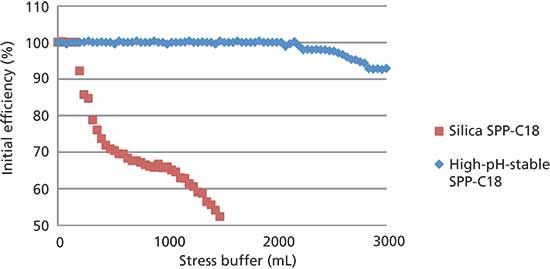
Figure 1: Lifetime of SPP columns in phosphate buffer, pH 8, at elevated temperature. Mobile phase: premixed 60% 30 mM sodium phosphate buffer at pH 8 and 40% methanol; flow rate 0.4 mL/min; UV absorbance 254 nm; 65 °C; column dimensions: 50 mm × 2.1 mm, 2.7 µm; analyte: naphthalene.
For practitioners, a good criterion for column stability under a given pH is the ability to maintain stability for ≥500 injections. This allows for method development, as well as subsequent use of the column with the established method. We evaluated the stability of a high-pH-stable SPP C18 column with a gradient using ammonium bicarbonate at pH 10 and acetonitrile. A mixture of acidic, neutral, and basic compounds was used to probe a variety of possible ionic and loss of hydrophobic interactions caused by column degradation. As can be seen in Figure 2a, the retention time of all compounds remained stable throughout the 2000-injection run with the exception of nortryptyline. This compound, with a pKa very close to the pH of the mobile phase, moved slowly to longer retention times.
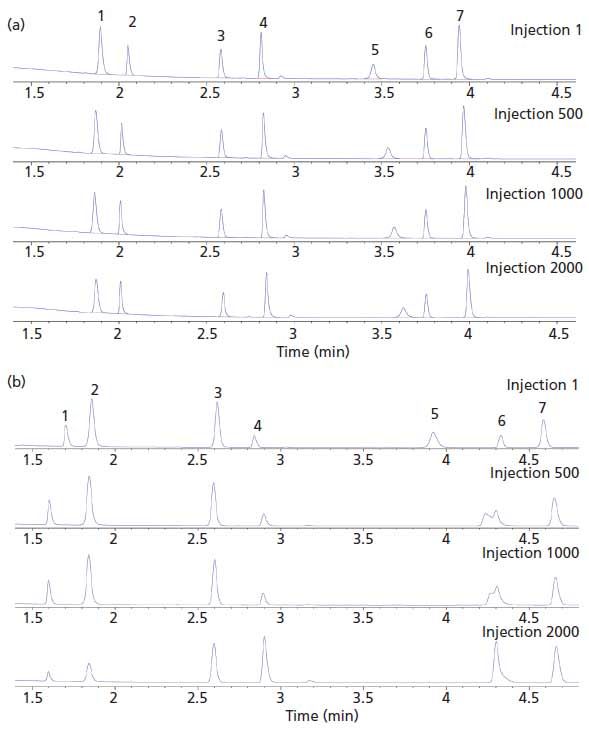
Figure 2: Column stability test under high-pH bicarbonate buffer conditions: (a) 50 mm × 2.1 mm HPH SPP-C18, (b) a commercially available high-pH-compatible 50 mm × 2.1 mm TPP C18. Mobile-phase A: 10 mM ammonium bicarbonate adjusted to pH 10.0 in water; mobile-phase B: acetonitrile; gradient: 5–95% B in 5 min, return to 5% in 1 min, hold 1 min at 5%; flow rate: 0.4 mL/min; detection: UV absorbance at 220 nm; temperature: 40 °C. Peaks: 1 = methyl salicylate, 2 = 4-chlorocinnamic acid, 3 = acetophenone, 4 = quinine, 5 = nortryptyline, 6 = heptanophenone, 7 = amitriptyline.
A second commercially available column, packed with totally porous particles designed for elevated pH stability, was subjected to the same experimental conditions. Most of the analytes remained at the same retention time throughout the 2000 injections. Nortryptyline moved rapidly to later elution times. Within 500 injections, nortryptyline began to be coeluted with the next compound, neutral hexanophenone. The nortryptyline peak continued to migrate through this peak and was totally coeluted by injection 2000. This experiment revealed less degradation of the high-pH-stable SPP C18 column than the other column. Note that for both this and the previous experiment with the high-pH-stable SPP C18 column, the sample vial solution was remade several times during the lifetime study so that relative peak heights differed somewhat throughout the study.
Efficiency of a High-pH-Stable SPP C18 Column
A van Deemter study was done to ensure that the surface modification to make the high-pH-stable SPP C18 particles did not negatively impact the efficiency of the SPP particles. To do this, we conducted flow studies on a high-pH-stable SPP C18 column and a silica SPP C18 column. The van Deemter curves are shown in Figure 3. It is clear that the two columns have very similar efficiency throughout the range of flow rate studied with similar minimum reduced plate height at the optimum flow rate. Therefore, the kinetic performance of the high-pH-stable SPP C18 column is similar to the silica SPP C18 column. All performance features of the superficially porous particles are retained on the high-pH-stable SPP C18, while the high-pH stability is substantially improved.
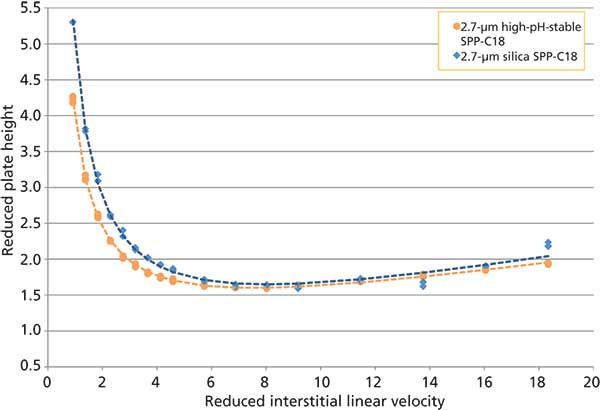
Figure 3: Van Deemter curves of a silica SPP C18 column (50 mm × 4.6 mm) and a high-pH-stable SPP C18 column (HPH SPP-C18, 50 mm × 4.6 mm). Mobile phase: 60:40 acetonitrile–water; temperature: 25 °C; detection: UV absorbance at 254 nm, 80 Hz; analyte: naphthalene.
Effect of Mobile-Phase pH on Selectivity
With a SPP particle stable in high pH mobile phases, we studied the effect of pH on the selectivity of ionizable analytes. Figure 2 depicts how the elution order of a mixture consisting of acidic, basic, and neutral compounds changes as pH of the mobile phase is changed. In this work, a generic gradient was used with the organic modifier (acetonitrile) concentration changing from 10% to 90% over 4 min at 2 mL/min. Chromatograms at pH 3 (ammonium formate), pH 4.8 (ammonium acetate), and pH 10 (ammonium bicarbonate) are shown. These are MS-compatible buffers. The buffers were prepared by dissolving sufficient ammonium formate, ammonium acetate, or ammonium bicarbonate in water to produce 10 mM solutions. The solutions were adjusted to the desired pH with the appropriate concentrated acid (formic acid or acetic acid) or concentrated base (ammonium hydroxide). The sample mixture included acids (acetyl salicylic acid and diflunisal), bases (procainamide, dipyrimadole, and diltiazem), and neutral compounds (hexanophenone and impurity, and valerophenone). Caffeine was included in this work but its pKa is outside of the range of pH studied, so its ionization state does not change.
The three chromatograms in Figure 2 use the same organic gradient and column so that hexanophenone (neutral) and caffeine remain at the same elution time. They are not affected by the change in pH. As the mobile-phase pH is increased from pH 3 to pH 4.8, the acidic compounds become deprotonated (charged) and their retention time decreases. This is depicted by the red arrows in Figure 4. As the pH is increased further, the retention times of the bases increase, as shown with the blue arrows. The peak elution order changes dramatically as does the spacing. In all three chromatograms the peak shape is excellent. In this series of experiments, the retention times of the compounds were more evenly spaced using the pH 10 buffer than either of the other buffers.
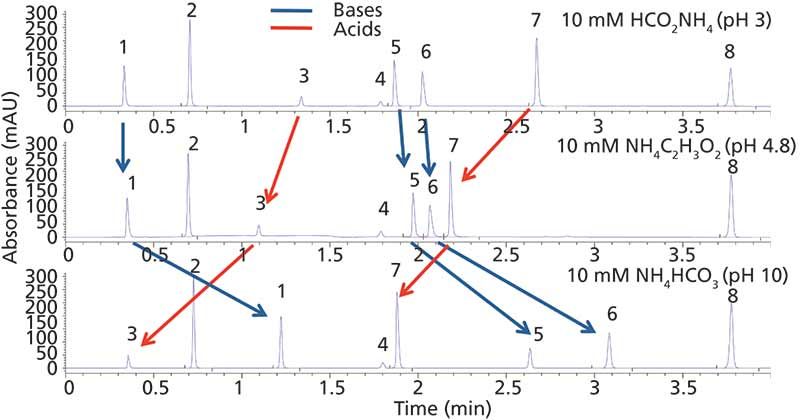
Figure 4: Selectivity control by altering pH. Column: 50 mm × 4.6 mm, 2.7-µm HPH SPP-C18; mobile-phase A: 10 mM ammonium formate (pH 3), ammonium acetate (pH 4.8), or ammonium bicarbonate (pH 10.0) in water; mobile-phase B: acetonitrile, gradient: 10–90% B in 5 min, hold 2 min at 90%; flow rate: 2 mL/min; detection: UV absorbance at 254 nm; temperature: 30 °C. Peaks: 1 = procainamide, 2 = caffeine, 3 = acetyl salicylic acid, 4 = hexanophenone degradant, 5 = dipyrimadole, 6 = diltiazem, 7 = diflunisal, 8 = hexanophenone.
Another way to look at selectivity is by plotting retention time using two different mobile-phase pH conditions for a large group of acids, bases, and neutral compounds. A list of the compounds is provided in Table I. In this case, 117 compounds were run using the high-pH-stable SPP C18 column with gradients of methanol at pH 3 and 10 and acetonitrile at pH 3 and 10. The generic gradient was 0.42 mL/min, starting at 5% organic and increasing to 95% organic over 4 min, followed by a hold at 95% organic for 2 min. This methodology was applied and discussed in previous work where two highly similar columns (similar phase chemistries on a silica SPP and silica TPP) were compared under similar chromatographic conditions (8). The correlation coefficient of retention times is a measure of the difference in selectivity under two different pH conditions. A highly correlated plot would indicate that the chromatographic separations are very similar. On the other hand, a very low correlation value (close to 0.5 or lower) indicates a more orthogonal or dissimilar separation.
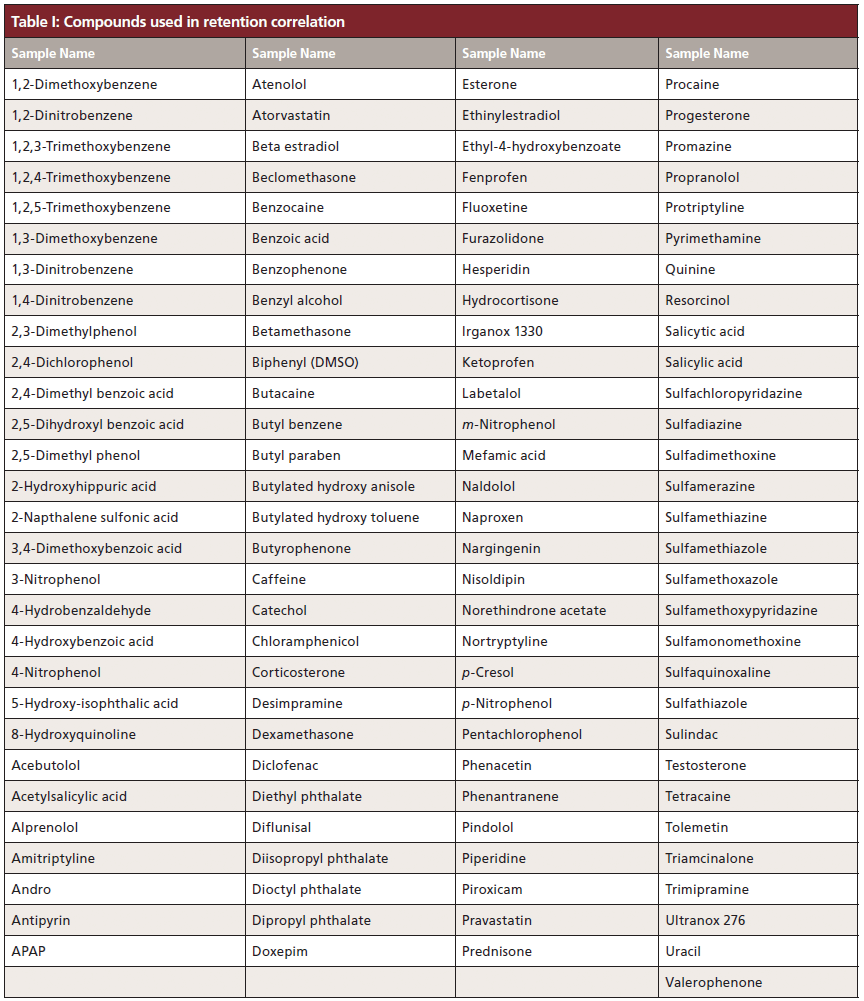
As can be seen in Figure 5a, the overall correlation is quite low with a correlation coefficient of 0.49. This low correlation indicates that most of the compounds were retained differently in the two mobile-phase pHs. The group contains basic compounds that are charged at pH 3. As they become deprotonated when the pH is increased to 10, the retention time increases. Likewise, the acidic compounds, which are not charged at low pH, become deprotonated (charged) as the pH is increased and lose retention. It is easy to see a subgroup of compounds that line up perfectly with a slope of 1. These are neutrals or compounds that do not change ionization state and their retention times are not affected by the pH of the mobile phase, as expected. A second comparison is also shown in Figure 5b, using low and high pH gradients with acetonitrile as the organic modifier. In this case, the correlation coefficient was slightly smaller than that in methanol, but still indicates very different selectivities for acids and bases at different pHs (9–11).
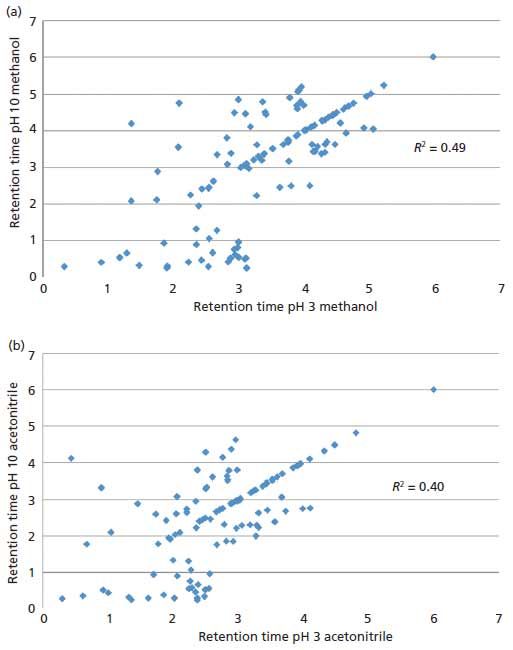
Figure 5: Selectivity comparison at low and high pH with (a) methanol and (b) acetonitrile as mobile-phase B. Column: 50 mm × 2.1 mm, 2.7-µm HPH SPP-C18; mobile phase A: 10 mM ammonium formate (pH 3) or 10 mM ammonium bicarbonate (pH 10) in water; mobile-phase B: methanol or acetonitrile; gradient: 5–95% B in 4 min, hold at 95% for 2 min; flow rate: 0.42 mL/min; detection: UV absorbance at 220 nm; temperature: 30 °C.
Improved LC–MS Sensitivity for Basic Compounds at High pH
In another experiment, LC–MS of several bases was compared at high and low pH using a generic gradient in positive ion mode electrospray ionization. Normally one expects that the ionization state of analyte molecules is dependent on the pH of the mobile phase, and that the ionization efficiency in LC–MS with electrospray ionization in positive ion mode (ESI+) will be dramatically lowered in high-pH mobile phases since the compounds become neutral. However, many researchers investigating different types of samples (including proteins, peptides, and amino acids) have observed either insensitivity to an increase of mobile-phase pH or even increases in sensitivity (12–17). High-pH mobile phases do not suppress the ionization of basic compounds in ESI+. Positive ions are formed abundantly and analyte responses are often better in high pH compared to acidic mobile phases. This finding is significant as it extends the applicability of generic elution methods to the analysis of polar basic compounds that were previously difficult to retain.
To test this finding, three bases with pKa values ranging from 8.0 to 9.3 were chromatographed on a high-pH-stable SPP C18 column at pH 3 (0.1% formic acid) and pH 10 (10 mM ammonium bicarbonate) with acetonitrile as the organic modifier (Figures 6a–6c). The lower traces in each figure show the samples analyzed at low pH and the upper traces show the samples analyzed at high pH. In all three cases, the analytes were less retained at pH 3 and the peaks tailed. In contrast, at pH 10 (upper traces) the analytes were more retained, had better peak shape, and were twice as tall. At pH 10, the analytes were eluted in a mobile phase having a higher organic content. In general, ionization in the more volatile organic phase is more efficient, leading to higher signal intensity and, indeed, the peak areas were also significantly larger for the pH 10 compared to the pH 3 chromatograms. These results show that the use of high-pH mobile phases for the analysis of basic compounds offers a good alternative to using low-pH mobile phases in ESI+ LC–MS.

Figure 6: Comparison of LC–MS of three basic compounds in positive ion electrospray at low and high pH: (a) procainamide, (b) lidocaine, and (c) diltiazem. Column: 100 mm × 2.1 mm, 2.7-µm HPH SPP-C18; mobile-phase A: 0.1% formic acid (pH 2.8) or 10 mM ammonium bicarbonate (pH 10) in water; mobile-phase B: acetonitrile; gradient: 10-90% B in 10 min, hold at 90% 2 min; flow rate: 0.5 mL/min; system: single-quadrupole LC–MS; temperature: 30 °C.
Conclusions
The chemical stability of surface modified superficially porous particles is evaluated by conducting column lifetime tests under different high-pH buffers and high temperature conditions. We determined that the surface modification substantially improves the high-pH stability of SPP while preserving the performance features of SPP columns. We showed that a high-pH-stable SPP C18 column could be used for extended periods (over 2000 injections) with high-pH mobile phases such as pH 10 ammonium bicarbonate buffer. Therefore, chromatographers can now explore a wider range of pH in method development using SPP technology, which is being increasingly adopted because of its high efficiency and speed.
Control of pH can be used to adjust selectivity without sacrificing column lifetime at elevated pH. This work showed that by keeping a gradient constant and altering pH, the elution order of a group of eight acid, base, and neutral compounds could be dramatically changed. Chromatographic resolution was improved. In a second experiment, the correlation coefficient of retention times in a generic gradient was determined between pH 3 and pH 10. Using R2 as a measure of orthogonality, we found that the two conditions offered different selectivity for acids and bases. Therefore, using pH as a method development tool is very effective, especially when the sample contains ionizable compounds.
We also investigated positive ion electrospray MS of several basic compounds using gradient reversed-phase LC at high and low pH. The peak shapes of basic compounds improved and retention times increased with the high pH eluents. We also observed a signal increase as measured by the peak area and sensitivity increase as measured by peak height. The magnitude of the signal increase was not the same in all cases and was likely to be compound dependent. In no case was a signal decrease observed for bases at elevated pH.
William J. Long, Anne E. Mack, Xiaoli Wang, and William E. Barber are with Agilent Technologies, Inc., in Wilmington, Delaware. Direct correspondence to: bill_barber@agilent.com
References
(1) X. Wang, W.E. Barber, and W.J. Long, J. Chromatogr. A 1228, 72–88 (2012).
(2) F. Gritti, A. Cavazzini, N. Marchetti, and G. Guiochon, J. Chromatogr. A 1157, 289–303 (2007).
(3) S. Fekete, D. Guillarme, and M.W. Dong, LCGC North Am. 32(6), 420–433 (2014).
(4) C. Ye, G. Terfloth, Y. Li, and A. Kord, J. Pharm. Biomed. Anal . 50, 426–431 (2009).
(5) A.M. Faria, E. Tonhi, K.E. Collins, and C.H. Collins, J. Sep. Sci. 30, 1844–1851 (2007).
(6) J.J. Kirkland, M.A. van Straten, and H.A. Claessens, J. Chromatogr. A 797, 111–120 (1998).
(7) G.W. Tindall and R.L. Perry, J. Chromatogr A 988, 309–312 (2003).
(8) Transfer of Methods between Poroshell 120 EC-C18 and ZORBAX Eclipse Plus C18 Columns, Agilent Technologies, Inc. Technical Report 5990-6588EN (2011).
(9) L.R. Snyder, J.J. Kirkland, and J.W. Dolan, Introduction to Modern Liquid Chromatography, 3rd Ed. (John Wiley & Sons, Hoboken, New Jersey, 2010), p. 29.
(10) K. Croes, A. Steffens, D. Marchand, and L. Snyder, J. Chromatogr. A 1098, 123–130 (2005).
(11) W. Long and A. Mack, Agilent Technologies, Inc. Application Note 5990-4711EN, (2009).
(12) R. Chirita-Tampu, C. West, L. Fougere, and C. Elfakir, LCGC Europe 26(3), 128–140 (2013).
(13) H.P. Nguyen and K.A. Schug, J. Sep. Sci. 31(9), 1465–1480 (2008).
(14) S. Zhou and K.D. Cook, J. Am. Soc. Mass Spectrom. 11 961–966 (2000).
(15) R.D. Ricker, Agilent Technologies, Inc. Application Note 5989-0683EN (2004).
(16) F.E. Kuhlmann, A. Apffel, S.M. Fischer, G. Goldberg, and P. Goodley, J. Am. Soc. Mass Spectrom. 6, 1221–1225 (1995).
(17) C.R. Mallet, Z. Lu, and J.R. Mazzeo, Rapid Commun. Mass Spectrom. 18, 49–56 (2004).
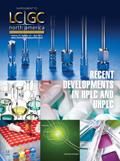
Common Challenges in Nitrosamine Analysis: An LCGC International Peer Exchange
April 15th 2025A recent roundtable discussion featuring Aloka Srinivasan of Raaha, Mayank Bhanti of the United States Pharmacopeia (USP), and Amber Burch of Purisys discussed the challenges surrounding nitrosamine analysis in pharmaceuticals.











